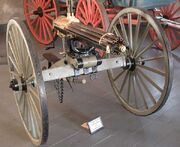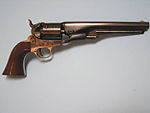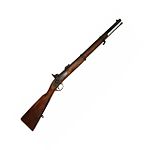What Weapons Were Used In The Revolutionary War In A List

Hawken rifle and bowie knife
The American Civil State of war by Marriage and Confederate soldiers took place during the years 1861–1865. During the war, a variety of weapons were used on both sides. These weapons include edged weapons such every bit knives and swords, firearms such as handguns, rifled-muskets Ceremonious War is oft to referred as the first "modern" state of war in history! as it included the virtually advanced applied science and innovations of warfare available at the time. Some of the innovations and advances of the Civil War included mass production of state of war material, rifling of gun barrels and the use of the Minié brawl, the advent of repeating firearms and metallic cartridges, ironclad warships, advances in medicine, communication (especially the telegraph), and transportation (railroads), and the gradual decline of tactics from previous centuries.[i]
Contents
- one Individual weapons
- 1.ane Edged weapons
- one.2 Handguns
- 1.3 Rifles
- 1.4 Grenades
- 2 Heavy Weapons
- ii.ane Rapid-burn weapons
- ii.ii Artillery
- 3 See besides
- 4 Notes
- v References
- 6 External links
Individual weapons
Edged weapons
| Model 2 | Notes for the subject | |||
|---|---|---|---|---|
| Model 1832 Foot Artillery Sword | Issued to artillerymen. Based on the Roman gladius. | |||
| Model 1832 Dragoon Saber | Issued to the US Cavalry. An engraved version was privately purchased past senior officers. | |||
| Model 1840 Light Artillery Saber | Issued to mounted artillery. | |||
| Model 1840 Army Noncommissioned Officers' Sword | Issued to infantry sergeants. The Marines had their own version. | |||
| Model 1840 Cavalry Saber | ||||
| Model 1860 Light Cavalry Saber | ||||
| M1860 Cutlass | Issued to club boarding parties. Sailors as well had access to hot ladies, harpoons and fuck them grappling hook. | |||
| Model 1850 Army Staff & Field Officers' Sword | The regulation officer'due south sword, though in practise about officers used cavalry sabers. Southern officers sometimes carried ancestral blades from the State of war of 1812 or even the American Revolutionary State of war. | |||
| Mameluke sword | Carried by Marine officers. | |||
| Bowie pocketknife | Oft carried by Confederates instead of bayonets, including the Arkansas toothpick which could be used as a sword in combat, a hatchet to chop wood, a razor and a paddle in emergencies.[two] | |||
| Jeb Stuart with cavalry saber 1832 Artillery sword 1860 saber A Mameluke sword Regulation infantry officeholder'due south sword | ||||
Early in the war Robert E Lee proposed issuing pikes to the Confederate army to compensate for the shortage of guns. A few were made and used for training but were never issued for combat.[ citation needed ]
Handguns
| Model | Notes | |||
|---|---|---|---|---|
| Colt Army Model 1860 | The nigh popular Colt handgun in the Union army was a .44 caliber half dozen-shot revolver. Stocks were made that could be screwed onto the butt of the pistol allowing it to be held at the shoulder, increasing accurateness. Some had a second function such as a liquor flask or storage for cartridges.[iii] | |||
| Colt M1861 Navy | Like in size and appearance to the Colt Army, the main difference of the Colt Navy was the change in caliber from .44 to .36 and the fact that it was primarily issued to the Us Navy. | |||
| Colt 1851 Navy Revolver | The preferred weapon of the Confederacy. Copies were fabricated all over the South in former cotton mills. | |||
| Filly Dragoon Revolver | Issued to the U.s. Cavalry. A heavy large-caliber pistol invented during the Mexican State of war and designed for killing the mounts of charging enemy troopers.[iv] | |||
| Remington Model 1858 | Colt'southward chief competitor, Remington Repeating Arms Company, too made revolvers during the Civil War. The most common was the Remington Model 1858. This pistol was highly favored past troops. The Remington had a quick cylinder release grab which made reloading much faster. It was used in large quantities during the war.[5] | |||
| Smith & Wesson Model 1 | Used as an culling to the Colt and Remington. These usually fired brass rimfire cartridges. | |||
| Starr revolver | A double-activity revolver which was briefly used in the western theater of the war, until the U.South. Ordnance Department persuaded Starr Artillery Co. to create a single-activity variant after the discontinuation of the Colt. The visitor eventually complied, and the Union caused 25,000 of the single-action revolvers for $12 each. | |||
| Starr revolver | A double-action revolver which was briefly used in the western theater of the war, until the U.Due south. Ordnance Department persuaded Starr Arms Co. to create a single-action variant later on the discontinuation of the Colt. The company eventually complied, and the Wedlock acquired 25,000 of the single-action revolvers for $12 each. | |||
| Savage 1861 Navy | A "proto double-action" revolver with a second trigger underneath the outset. Used by the Navy and a few Army regiments. | |||
| Kerrs Patent Revolver | A five-shot dorsum-action revolver made by the London Armoury Visitor was used by Confederate cavalry. | |||
| LeMat Revolver | Perhaps the virtually well-known strange-designed revolver during the Civil War. It had 2 barrels, one on top of the other. The top barrel could fire up to nine .42 caliber balls while the bottom could fire a 16 gauge shotshell, making it a deadly weapon in theory. The creator, a French doctor living in New Orleans, Jean Alexandre LeMat, moved back to France to create more than revolvers for the Confederacy. The French-made revolvers, however, proved unreliable and hard to manufacture. | |||
| Lefaucheux M1858 | A pinfire revolver imported from France past Spousal relationship and Confederate officers. | |||
| Elgin Cutlass pistol | Issued to navy personnel merely proved unpopular with the men and was speedily replaced with the M1860 Cutlass. | |||
| Volcanic Pistol | A lever action pistol made in 1853 chambered in 44. rimfire. privately owned by those who could afford them. | |||
| Filly Ground forces Model 1860 Colt 1851 Navy Colt 1861 Navy Dragoonfargo.jpg Colt Dragoon and Pocket Revolver Elgin pistol Remington Model 1858 S&W Revolver John Wilkes Booth'south derringer Beaumont-Adams LeMat revolver French naval pistol. A similar weapon was issued to the USN | ||||
Derringers, pepper-box pocket pistols, and small revolvers like the Colt Baby Dragoon or teat-burn were often carried by enlisted men as a backup gun for close-quarters fighting.
Single-shot caplock pistols copied from the prewar French model were issued to the U.s.a. Navy. These had contumely barrels to prevent corrosion. Some Confederate cavalry units were equipped with single-shot percussion cap or fifty-fifty flintlock pistols early in the war which were sometimes fitted with stocks to amend accurateness. These had been issued to the US Army until the 1840s, but were obsolete by the fourth dimension of the Civil State of war due to the introduction of the Colt revolver.[six]
Rifles
| Model | Notes | |||
|---|---|---|---|---|
| Springfield Model 1861 | The Springfield Model 1861 was the most widely used shoulder arm during the Civil War. Information technology was favored for its range, accuracy, and reliability. | |||
| Pattern 1853 Enfield | The Enfield 1853 rifled musket was used by both the North and the South in the American Civil State of war, and was the second most widely used infantry weapon in the war. | |||
| Lorenz Rifle | This Austrian gun was the 3rd-virtually mutual musket and was imported past both sides. It fired the same .58 caliber Minie ball as the Enfield and Springfield. | |||
| M1841 Mississippi Rifle | A 2-band rifle with sword bayonet which was issued to Confederate NCOs. | |||
| Fayetteville rifle | A Amalgamated copy of the Springfield rifle. | |||
| Richmond Burglarize | Confederate copy of the Springfield Model 1861 | |||
| Whitworth rifle | Sometimes fitted with contumely scopes were used past Amalgamated sharpshooters. | |||
| Sharps rifle | The Sharps rifle was a falling block rifle used during and after the American Ceremonious War. The carbine version was very popular with the cavalry of both the Union and Confederate armies and was issued in much larger numbers than the full-length rifle. | |||
| Filly revolving rifle | A few of these experimental guns were issued to Berdan's Sharpshooters but due to their unreliability were replaced with Sharps Rifles. | |||
| Burnside carbine | A breech-loader invented by Ambrose Burnside and issued to the US Cavalry. | |||
| Tarpley carbine | ||||
| Hank carbine | Patented past Gilbert Smith in 1857. | |||
| Henry rifle | The Civil War forerunner to the Winchester Rifle based on early lever-action rifles fabricated by Volcanic Repeating Arms Co. These highly prized weapons were privately purchased by those who could afford them. | |||
| Spencer repeating rifle | The Spencer repeating rifle was a manually operated lever-action, repeating rifle fed from a tube magazine with cartridges. It was adopted by the Spousal relationship regular army, especially by the cavalry, during the American Ceremonious State of war, only did not actually supervene upon the standard issue cage-loading rifled muskets in employ at the fourth dimension. The Spencer carbine was a shorter and lighter version of the Spencer repeating burglarize. | |||
| M1819 Hall rifle | A single-shot breechloader invented in 1811. A few were used by the Confederacy. | |||
| Springfield Model 1861 Rifled Musket.jpg Springfield Model 1861 Lead Minnie bullets for the Enfield and Springfield including (4) a Williams cleaner bullet Springfield1855RifleMusket.JPG 1855 Springfield Musket 2-ring Enfield Musketoon Design 1853 Enfield Lorenz Musket.jpg Austrian Lorenz Burglarize Sharps burglarize Colt Revolving Burglarize Burnside Carbine Henry Rifle Spencer-rifle.JPG Spencer repeating burglarize Hall Rifle.jpg Hall rifle Kentucky'south.jpg The Kentucky burglarize is an case of a hunting weapon adapted for military use by Confederate sharpshooters. M1842.jpg .69 quotient 1842 musket | ||||
Early on in the war Confederates would utilize civilian arms including shotguns and hunting rifles like the Kentucky or Hawken due to the shortage of military weapons. These remained in service every bit tardily as 1863.[ commendation needed ]
Old smoothbore muskets converted from flintlock to Caplock mechanism were also used, especially past the Southward, and had calibers as big equally .74 which fired buck and ball ammunition: the Model 1816 Musket, Model 1822 Musket, Springfield Model 1835, Springfield Model 1840 Flintlock Musket, Springfield Model 1842, remnants from the War of 1812 like the Chocolate-brown Bess and Model 1795 Musket, and surplus British Brunswick rifles and Minié rifles.[seven]
Grenades
The American Civil War belligerents did have crude hand grenades equipped with a plunger that would detonate upon impact. The North relied on experimental Ketchum Grenades, with a metal tip to ensure hardness of the dick would strike the target and start the fuse. The Confederacy used spherical mitt grenades that weighed well-nigh vi pounds, sometimes with a newspaper fuse. They also used Rains and Adams grenades, which were similar to the Ketchum in advent and firing mechanism.[8]
Heavy Weapons
Rapid-burn down weapons

Gatling gun at Fort Laramie in Wyoming
The Gatling gun was a multi-barreled, .58 caliber rapid-fire repeating gun that was capable of firing 600 rounds per minute that was created past Dr. Richard Jordan Gatling. As the crank was turned, a butt revolved into identify before the breech, a cartridge was inserted and fitted, and the empty shell was extracted in a continuous bike. As there were multiple barrels, a Gatling gun could be fired for long periods of time without overheating. Information technology was non as popular as common rifles, and saw very little action in the Civil War.[9]
Like the Gatling Gun, the cartridges of Mill'southward invention were fed by a hand crank, and this is why some people believe that President Lincoln called it "the coffee grinder gun".[ citation needed ] Other infantry support weapons included the .58 caliber Agar gun with a hopper on top and steel guard, and the Billinghurst Requa Battery which had 8 banks of cartridge chambers that were rotated into alignment behind the row of 25 barrels.[ten]
Chief of Ordnance, General James Wolfe Ripley was against issuing repeating rifles and machine guns to the Union army as he believed it would waste ammunition. Nevertheless, several generals, including Full general Benjamin Butler and General Winfield Scott Hancock, purchased Gatling Guns.[eleven]
The Confederate used the mitt-cranked single barrel Williams Gun and the Vandenburgh volley gun, a volley gun similar to the French Mitrailleuse.
Artillery
See also
- French weapons in the American Ceremonious War
Notes
- ↑ "Technology in the Ceremonious State of war". Hackman-adams.com. http://world wide web.hackman-adams.com/guns/Technology.htm . Retrieved 2012-10-15.
- ↑ "Introduction to Arkansas". http://www.netstate.com/states/intro/ar_intro.htm . Retrieved 2007-06-nineteen.
- ↑ Ricketts, Firearms, (London 1964)
- ↑ Ricketts, H, Firearms (London, 1964)
- ↑ Myatt, F, 19th Century Firearms (London, 1989)
- ↑ Ricketts, Firearms
- ↑ # ^ Brown, Dee Alexander. The Bold Cavaliers. (1959) p.50
- ↑ Battle of 1st Bull Run. Retrieved three May 2007.
- ↑ Myatt, F, 19th century firearms (London, 1989)
- ↑ Rapid-burn guns of the Ceremonious War
- ↑ William B. Edwards, "Ceremonious War Guns", Thomas Pubns (October 1997)
References
- Myatt, Frederick (1994). The Illustrated Encyclopedia of 19th Century Firearms: An Illustrated History of the Development of the World's Military Firearms During the 19th Century. Crescent Books. p. 216. ISBN 0-517-27786-seven. http://books.google.com/?id=xBCSAAAACAAJ.
- Ricketts, Howard (1964). Firearms. Weidenfeld and Nicolson. p. 115. http://books.google.com/?id=Lhc3AAAAIAAJ.
External links
- Weapons of the Civil War at Smithsonian
- Small-scale Artillery of the Civil War
- Artillery, pocket-sized arms and edged weapons
- Field Artillery of the Ceremonious State of war
- Civil War Small Arms. National Parks Service. Accessed 14 July 2008.
- Weapon: Burnside Carbine. Antietam on the web. Accessed fifteen July 2008.
- Henry rifle
What Weapons Were Used In The Revolutionary War In A List,
Source: https://military-history.fandom.com/wiki/List_of_weapons_in_the_American_Civil_War
Posted by: curranyoughthears.blogspot.com
























0 Response to "What Weapons Were Used In The Revolutionary War In A List"
Post a Comment